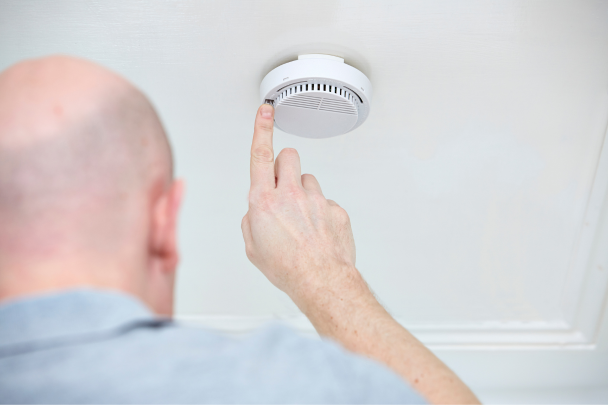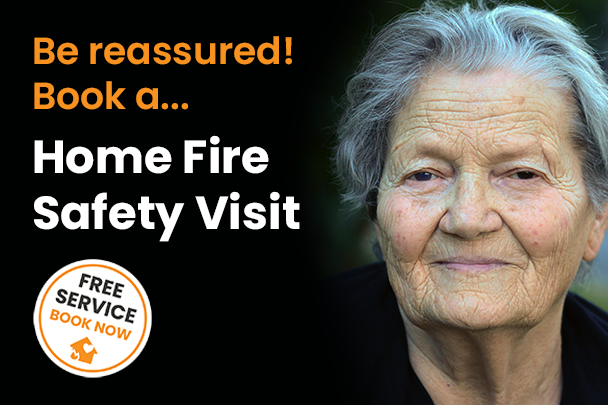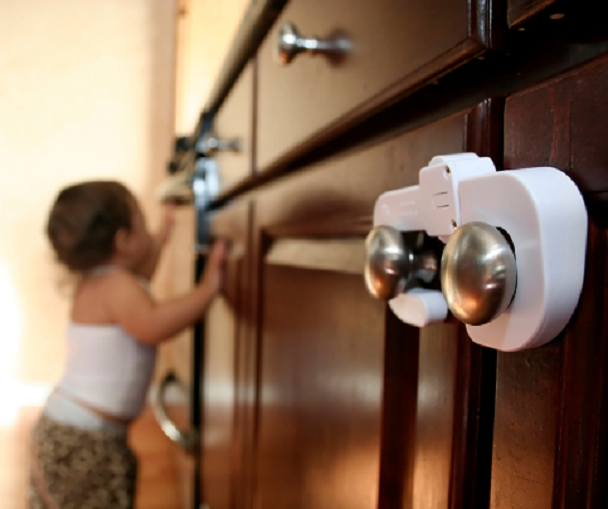Smoke and CO Alarms
Do you have working smoke alarms on every floor of your house?

Fire Prevention in the Home
Follow this NFCC advice
Installing Smoke Alarms
House fires are the main cause of fire deaths and injury and you are more than twice as likely to die in a fire at home if you haven’t got a working smoke alarm.
If you do not have a working smoke alarm then please buy one in DIY stores and from reputable online stores. Smoke alarms are proven to give people significant early warning to escape their homes and alert the Fire Service.
You should have one smoke alarm on each floor of the house, in a central hallway location. They should be placed on the ceiling, at least 30cm from a light fitting.
If you have only one alarm make sure it is somewhere you’ll be able to hear it when you’re asleep. If you have a large electrical appliance, like a computer, in any of your bedrooms, you should fit a smoke alarm there too.
If it is difficult for you to fit your smoke alarm yourself, ask a family member or friend to help you.
Types of Smoke Alarm
There are two main types of smoke alarm - ionisation alarms and optical alarms.
Ionisation alarms
These are the cheapest and the most readily available. They are very sensitive to flaming fires, (ones that burn fiercely such as chip-pan fires) and they will detect this type of fire before the smoke gets too thick.
Optical alarms
These are more expensive and more effective at detecting slow-burning fires (such as smouldering foam-filled furniture and overheated wiring). Optical alarms are less likely to go off accidentally, and so are best for ground-floor hallways and for homes on one level.
As both slow-burning and flaming fires are common, for the best protection you should install one of each. However, if you can't have both it's still safer to have one smoke alarm than none at all.
Regular checks
Test all your smoke alarms once a week by pressing the test button until the alarm sounds
Replace battery
Change the battery once a year (unless it is a 10-year alarm)
Replace alarm
Replace the whole unit at least every 10 years
Stay protected
Never remove the batteries apart from when replacing them.
Beeping sound
If it starts beeping and won't stop, contact the manufacturer.
Protect yourself from Carbon Monoxide (CO)
What is carbon monoxide?
Carbon monoxide (CO) is a poisonous gas produced when gas, oil, coal, wood or other carbon fuels don't burn properly. Because it has no smell, taste or colour it is hard to detect and you might be breathing it without realising it. It can be fatal or cause permanent damage to your health.
What causes carbon monoxide poisoning?
When fuels such as gas, oil, coal and wood burn in an enclosed room all the oxygen is gradually used up and replaced with carbon dioxide, this prevents the fire burning properly and causes it to release poisonous carbon monoxide.
Carbon monoxide is produced by:
- Indoor use of a barbecue grill or outdoor heater;
- Using cooking appliances for heating purposes;
- Burning fuel in an enclosed or unventilated spaces, where there are no air vents, windows or doors left open or ajar;
- Faulty, damaged or worn out heating or cooking appliances;
- Poorly maintained heating and cooking appliances;
- Not servicing appliances regularly;
- Badly ventilated rooms - sealed windows, no air bricks;
- Chimneys or flues blocked by birds’ nests, fallen bricks, growing vegetation, bad DIY etc.;
- Poor or improper installation or use of heating and cooking appliances;
- Running engines such as cars or lawnmowers in garages with doors closed;
- Chemical fumes from cleaning fluids and paint removers that contain methylene chloride (dichloromethane).
Look for these danger signs
Even though it has no smell, taste or colour there are warning signs that carbon monoxide may be in the air:
- yellow or orange flames instead of the normal blue flames;
- sooty stains on the walls around fires and water heaters;
- sharing a wall or chimney with a neighbouring house where there is a carbon monoxide leak, even if your house does not have one.
Protect yourself with a carbon monoxide alarm
Carbon monoxide (CO) poisoning causes over 50 deaths a year.
These can be purchased from a reputable retailer, online or in store. Take care to ensure that you are buying a quality audible alarm. Look out for the kitemark which will ensure that the alarm complies with British Standards. Ensure that you instal the alarm according to manufacturers instructions and that the alarm is tested once a week. You may need one alarm for each room in the property that has a fuel-burning appliance, so be mindful that you may need to purchase more than one.
Other tips to reduce your risk include:
Following these tips to reduce your risk of suffering from carbon monoxide poisoning:
- Make sure home heating and cooking appliances are safe and well maintained;
- Boilers, cookers, heating systems and other appliances that burn gas, oil, coal and wood (all carbon based fuels) should be installed and regularly serviced by a reputable, registered engineer;
- Make sure rooms are well-ventilated and do not block air vents;
- For double-glazed or draught-proofed homes ensure there is still enough air circulating for any gas, oil, coal and wood burning home heating and cooking appliances that are in the room;
- Always use gas or other carbon-fuelled tools in a well-ventilated area and put the engine unit and exhaust outside;
- Do not use carbon fuelled equipment and tools inside your home if you can avoid it;
- Always use a safety mask when using chemicals that contain methylene chloride;
- Do not leave petrol-fuelled lawnmowers or cars running in the garage;
- Do not burn charcoal (e.g. disposable barbecue or outdoor heater) either indoors or in an enclosed space (e.g. tent, caravan or garage);
- Do not sleep in a room that has an unflued gas fire or a paraffin heater;
- Fit an extractor fan in your kitchen (if it does not already have one);
- Do not use a barbecue or chiminea inside your home for cooking or for heating.
Carbon monoxide poisoning symptoms:
The symptoms of carbon monoxide poisoning include:
- Nausea/sickness
- Dizziness
- Drowsiness/tiredness/general lethargy
- Headaches, becoming severe as exposure to carbon monoxide continues
- Impaired mental ability/confusion
- Chest or stomach pains
- Shortness of breath/difficulty in breathing
- Pink skin and bright red lips in severe poisoning cases
If you suspect you have carbon monoxide poisoning, don't hesitate to visit your GP as soon as possible. Diagnosing carbon monoxide poisoning is not easy because it can be like many other conditions, such as food poisoning or the ‘flu, so explain what you think is wrong to the Doctor.
Ask for either a blood and/or sample of breath to be taken without delay so they can measure any build up in your blood. Your body's carbon monoxide level falls the longer you are away from the contaminated environment, making it harder to diagnose and detect.


